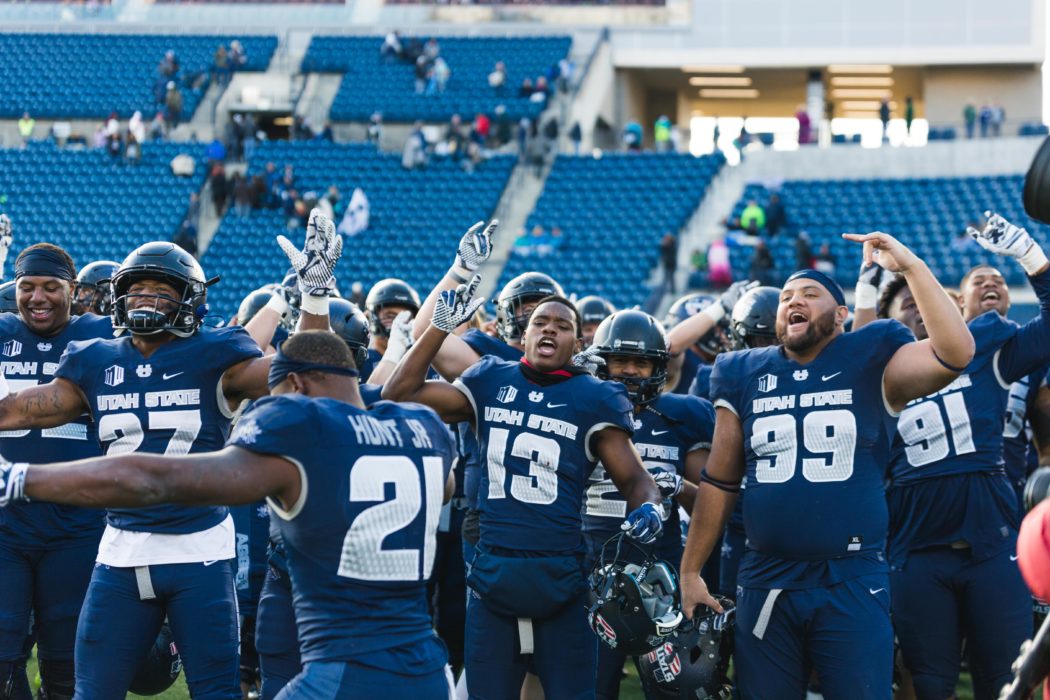Aggie showdown: 2017 Arizona Bowl preview
As fellow Statesman sports staffer Logan Jones succinctly put early this season, a bowl game is simply a reward for beating the teams you’re expected to beat. This year’s Utah State football team is a prime example. USU has reached the 6-win plateau with victories over FCS-level Idaho State, San Jose State, BYU, UNLV, New Mexico, and Hawaii. None of those strike as overly impressive wins, with UNLV’s 95th-ranked S&P rating being the highest USU has beaten this season. To the Aggies’ credit, they’ve gone 5-1 against teams ranked 95th or lower in the S&P rankings, and the NOVA Home Loans Arizona Bowl is their reward.
The issue therein is that no team still playing is going to be an easy victory. New Mexico State enters the Arizona Bowl ranked 69th in those same S&P rankings (USU stands at 55th). NMSU boasts one of the nation’s premier passing offenses. The Aggies of Las Cruces rank fourth in the nation in passing yards per game, as senior QB Tyler Rogers has thrown for nearly 4,000 yards on the season with 26 touchdowns. RB Larry Rose III has over 1,200 yards from scrimmage on the year. The defense ranks fourth in the entire country in sacks per game, averaging 3.3 per contest.
Utah State will receive a fight from their former conference opponent, and no one should be surprised if NMSU wins their first bowl game in nearly 60 years. However, USU is favored by four points in this game for a reason, and it all starts with a rejuvenated rushing attack.
143.7 first seven games, 86.6 removing SJSU and Idaho state
207 last five games, 235.5 removing Boise State
To be blunt about things, the Aggie rushing attack was quite toothless in the early portion of the season. In the first seven games of the season, USU averaged only 143.7 rushing yards per game, which would have ranked 91st in the nation over a full season. That figure worsens to 86.6 yards per game and third-worst in the nation after removing USU’s performances against San Jose State and Idaho State, two overmatched opponents from whom the Aggies received little resistance. Utah State went 3-4 in that stretch, largely due to the team being plus-8 in turnover margin in victories.
The narrative of the rushing game switched over the last five games, though, as USU has averaged 207 yards per game in their past five contests. That includes Boise State, who boasts the 18th-best rushing defense in the country. Removing that game, USU’s averages rise to 235.5 yards per game.
While numerous Aggies have been involved in USU’s resurrection running game, from sophomore Gerold Bright to junior Aaren Vaughns, but perhaps none have been as consistently responsible as senior RB Lajuan Hunt. In those first seven games, Hunt averaged a mere 3.7 yards per rush, but has turned around his season and averaged 5.7 yards per carry in USU’s past five games.
Freshman QB Jordan Love may receive heaps of praise and credit for Aggie victories, but this team lives and dies with the running game, specifically first downs by way of the ground. This season, USU has averaged over 10 rushing first downs per game in victories, compared to only five in losses. The ability to sustain drives on the ground, and allot a talented defense enough time on the sideline to recuperate, has been a key ingredient in all of USU’s runaway victories this season.
Versus New Mexico State, the running game will be imperative in slowing down NMSU’s pass rush, as well as allowing USU’s secondary time to recover against New Mexico State air raid attack. A young offensive line for Utah State will be stretched tremendously in this game, and their performance may greatly indicate the overall trajectory of Utah State football as a program. The Aggies made a blatant push to bolster the offensive line as a part of early signing day this past week; the staff knows how important line play will be in restoring USU to their most recent string of success. The Arizona Bowl will act as a rudimentary benchmark to see how close they are to fulfilling it.
New Mexico State will be looking to win in Tucson through the air, relying on an experienced QB and passing attack to do so. Utah State’s best defense will be their rushing offense, shortening and controlling the game as much as possible.

